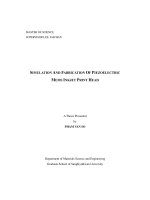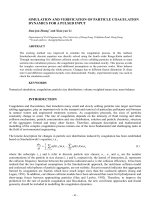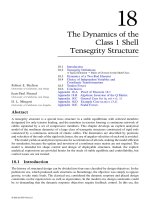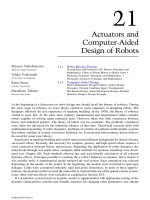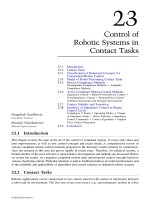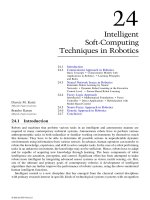modeling simulation and control of electrical drives edited pdf
Bạn đang xem bản rút gọn của tài liệu. Xem và tải ngay bản đầy đủ của tài liệu tại đây (29.83 MB, 741 trang )
IET CONTROL, ROBOTICS AND SENSORS SERIES 118
Modeling, Simulation and
Control of Electrical Drives
www.TechnicalBooksPDF.com
Other volumes in this series:
Volume 8
Volume 9
Volume 18
Volume 20
Volume 28
Volume 33
Volume 34
Volume 35
Volume 37
Volume 39
Volume 40
Volume 41
Volume 42
Volume 44
Volume 47
Volume 49
Volume 50
Volume 51
Volume 52
Volume 53
Volume 54
Volume 55
Volume 56
Volume 57
Volume 58
Volume 59
Volume 60
Volume 61
Volume 62
Volume 63
Volume 64
Volume 65
Volume 66
Volume 67
Volume 68
Volume 69
Volume 70
Volume 71
Volume 72
A History of Control Engineering, 1800–1930 S. Bennett
Embedded Mechatronics System Design for Uncertain Environments:
Linux‡-based, Rasbpian‡, ARDUINO‡ and MATLAB‡ xPC Target
Approaches C.S. Chin
Applied Control Theory, 2nd Edition J.R. Leigh
Design of Modern Control Systems D.J. Bell, P.A. Cook and N. Munro (Editors)
Robots and Automated Manufacture J. Billingsley (Editor)
Temperature Measurement and Control J.R. Leigh
Singular Perturbation Methodology in Control Systems D.S. Naidu
Implementation of Self-tuning Controllers K. Warwick (Editor)
Industrial Digital Control Systems, 2nd Edition K. Warwick and D. Rees
(Editors)
Continuous Time Controller Design R. Balasubramanian
Deterministic Control of Uncertain Systems A.S.I. Zinober (Editor)
Computer Control of Real-time Processes S. Bennett and G.S. Virk (Editors)
Digital Signal Processing: Principles, devices and applications N.B. Jones
and J.D. McK. Watson (Editors)
Knowledge-based Systems for Industrial Control J. McGhee, M.J. Grimble
and A. Mowforth (Editors)
A History of Control Engineering, 1930–1956 S. Bennett
Polynomial Methods in Optimal Control and Filtering K.J. Hunt (Editor)
Programming Industrial Control Systems Using IEC 1131-3 R.W. Lewis
Advanced Robotics and Intelligent Machines J.O. Gray and D.G. Caldwell
(Editors)
Adaptive Prediction and Predictive Control P.P. Kanjilal
Neural Network Applications in Control G.W. Irwin, K. Warwick and K.J. Hunt
(Editors)
Control Engineering Solutions: A practical approach P. Albertos, R. Strietzel
and N. Mort (Editors)
Genetic Algorithms in Engineering Systems A.M.S. Zalzala and P.J. Fleming
(Editors)
Symbolic Methods in Control System Analysis and Design N. Munro
(Editor)
Flight Control Systems R.W. Pratt (Editor)
Power-plant Control and Instrumentation: The control of boilers and
HRSG systems D. Lindsley
Modelling Control Systems Using IEC 61499 R. Lewis
People in Control: Human factors in control room design J. Noyes and
M. Bransby (Editors)
Nonlinear Predictive Control: Theory and practice B. Kouvaritakis and
M. Cannon (Editors)
Active Sound and Vibration Control M.O. Tokhi and S.M. Veres
Stepping Motors, 4th Edition P.P. Acarnley
Control Theory, 2nd Edition J.R. Leigh
Modelling and Parameter Estimation of Dynamic Systems J.R. Raol, G. Girija
and J. Singh
Variable Structure Systems: From principles to implementation
A. Sabanovic, L. Fridman and S. Spurgeon (Editors)
Motion Vision: Design of compact motion sensing solution for
autonomous systems J. Kolodko and L. Vlacic
Flexible Robot Manipulators: Modelling, simulation and control
M.O. Tokhi and A.K.M. Azad (Editors)
Advances in Unmanned Marine Vehicles G. Roberts and R. Sutton (Editors)
Intelligent Control Systems Using Computational Intelligence Techniques
A. Ruano (Editor)
Advances in Cognitive Systems S. Nefti and J. Gray (Editors)
Control Theory: A guided tour, 3rd Edition J.R. Leigh
www.TechnicalBooksPDF.com
Volume 73
Volume 74
Volume 75
Volume 76
Volume 77
Volume 78
Volume 80
Volume 81
Volume 83
Volume 84
Volume 86
Volume 88
Volume 89
Volume 90
Volume 91
Volume 92
Volume 93
Volume 94
Volume 95
Volume 96
Volume 99
Volume 100
Volume 102
Volume 104
Volume 105
Volume 107
Volume 108
Volume 111
Volume 112
Volume 113
Volume 114
Volume 117
Volume 119
Volume 121
Adaptive Sampling with Mobile WSN K. Sreenath, M.F. Mysorewala,
D.O. Popa and F.L. Lewis
Eigenstructure Control Algorithms: Applications to aircraft/rotorcraft
handling qualities design S. Srinathkumar
Advanced Control for Constrained Processes and Systems F. Garelli,
R.J. Mantz and H. De Battista
Developments in Control Theory towards Glocal Control L. Qiu, J. Chen,
T. Iwasaki and H. Fujioka (Editors)
Further Advances in Unmanned Marine Vehicles G.N. Roberts and R. Sutton
(Editors)
Frequency-domain Control Design for High-performance Systems
J. O’Brien
Control-oriented Modelling and Identification: Theory and practice
M. Lovera (Editor)
Optimal Adaptive Control and Differential Games by Reinforcement
Learning Principles D. Vrabie, K. Vamvoudakis and F. Lewis
Robust and Adaptive Model Predictive Control of Nonlinear Systems
M. Guay, V. Adetola and D. DeHaan
Nonlinear and Adaptive Control Systems Z. Ding
Modeling and Control of Flexible Robot Manipulators, 2nd Edition
M.O. Tokhi and A.K.M. Azad
Distributed Control and Filtering for Industrial Systems M. Mahmoud
Control-based Operating System Design A. Leva et al.
Application of Dimensional Analysis in Systems Modelling and Control
Design P. Balaguer
An Introduction to Fractional Control D. Vale´rio and J. Costa
Handbook of Vehicle Suspension Control Systems H. Liu, H. Gao and P. Li
Design and Development of Multi-lane Smart Electromechanical
Actuators F.Y. Annaz
Analysis and Design of Reset Control Systems Y. Guo, L. Xie and Y. Wang
Modelling Control Systems Using IEC 61499, 2nd Edition R. Lewis and
A. Zoitl
Cyber-Physical System Design with Sensor Networking Technologies
S. Zeadally and N. Jabeur (Editors)
Practical Robotics and Mechatronics: Marine, space and medical
applications I. Yamamoto
Organic Sensors: Materials and applications E Garcia-Breijo and P Cosseddu
(Editors)
Recent Trends in Sliding Mode Control L. Fridman J.P. Barbot and F. Plestan
(Editors)
Control of Mechatronic Systems L. Guvenc, B.A. Guvenc, B. Demirel,
M.T. Emirler
Mechatronic Hands: Prosthetic and robotic design P.H. Chappell
Solved Problems in Dynamical Systems and Control D. Vale´rio, J.T. Machado,
A.M. Lopes and A.M. Galhano
Wearable Exoskeleton Systems: Design, control and applications S. Bai,
G.S. Virk and T.G. Sugar
The Inverted Pendulum in Control Theory and Robotics: From theory to
new innovations O. Boubaker and R. Iriarte (Editors)
RFID Protocol Design, Optimization, and Security for the Internet of
Things A.X. Liu, M. Shahzad, X. Liu and K. Li
Design of Embedded Robust Control Systems Using MATLAB‡/Simulink‡
P.H. Petkov, T.N. Slavov and J.K. Kralev
Signal Processing and Machine Learning for Brain-Machine Interfaces
T. Tanaka and M. Arvaneh (Editor)
Data Fusion in Wireless Sensor Networks D. Ciuonzo and P.S. Rossi (Editors)
Swarm Intelligence Volumes 1–3 Y. Tan (Editor)
Integrated Fault Diagnosis and Control Design of Linear Complex Systems
M. Davoodi, N. Meskin and K. Khorasani
www.TechnicalBooksPDF.com
This page intentionally left blank
www.TechnicalBooksPDF.com
Modeling, Simulation and
Control of Electrical Drives
Edited by
Muhammed Fazlur Rahman and Sanjeet K. Dwivedi
The Institution of Engineering and Technology
www.TechnicalBooksPDF.com
Published by The Institution of Engineering and Technology, London, United Kingdom
The Institution of Engineering and Technology is registered as a Charity in England &
Wales (no. 211014) and Scotland (no. SC038698).
† The Institution of Engineering and Technology 2019
First published 2019
This publication is copyright under the Berne Convention and the Universal Copyright
Convention. All rights reserved. Apart from any fair dealing for the purposes of research
or private study, or criticism or review, as permitted under the Copyright, Designs and
Patents Act 1988, this publication may be reproduced, stored or transmitted, in any
form or by any means, only with the prior permission in writing of the publishers, or in
the case of reprographic reproduction in accordance with the terms of licences issued
by the Copyright Licensing Agency. Enquiries concerning reproduction outside those
terms should be sent to the publisher at the undermentioned address:
The Institution of Engineering and Technology
Michael Faraday House
Six Hills Way, Stevenage
Herts, SG1 2AY, United Kingdom
www.theiet.org
While the authors and publisher believe that the information and guidance given in this
work are correct, all parties must rely upon their own skill and judgement when making
use of them. Neither the authors nor publisher assumes any liability to anyone for any
loss or damage caused by any error or omission in the work, whether such an error or
omission is the result of negligence or any other cause. Any and all such liability is
disclaimed.
The moral rights of the authors to be identified as authors of this work have been
asserted by them in accordance with the Copyright, Designs and Patents Act 1988.
MATLAB‡ and Simulink‡ are trademarks of The MathWorks, Inc.
British Library Cataloguing in Publication Data
A catalogue record for this product is available from the British Library
ISBN 978-1-78561-587-0 (hardback)
ISBN 978-1-78561-588-7 (PDF)
Typeset in India by MPS Limited
Printed in the UK by CPI Group (UK) Ltd, Croydon
www.TechnicalBooksPDF.com
Contents
About the editors
Preface
Foreword
xix
xxi
xxiii
1 Introduction to electric drives
Muhammed Fazlur Rahman
1
1.1 The role of motor drives in modern industry and energy usage
1.2 Controller hierarchy for electric drives
1.3 Quadrant operation of a drive and typical load torque
1.4 Power switch and integrated control devices for drive systems
1.5 Overview of chapters
List of symbols
Glossary of terms
Further reading
1
3
7
8
9
12
13
13
2 Electric machines, dynamic models and sensors in drive systems
Mohammad Fazlur Rahman, Rukmi Dutta and Dan Xiao
15
2.1 Introduction
2.2 Electric machines and torque–speed (T–w) boundaries
2.3 T–w characteristics within torque–speed boundaries
2.4 Dynamic models of machines and simulation
2.4.1 Dynamic model of DC machines
2.4.2 Dynamics model of synchronous machines in rotor
reference frame [1]
2.4.3 Dynamic model of induction machines in synchronous
reference frame
2.5 Simulation of drive systems
2.5.1 Tuning of an electric drive using a cascaded structure [4]
2.5.2 Voltage reference amplitude limitation
2.5.3 Pulse-width modulation block
2.6 Sensors in drive systems
2.6.1 Current sensors for electric drive systems
2.6.2 Speed sensors for electric drive systems
2.7 Recent developments in PM machines; with reference to
developments of other types: DCM and IM
2.7.1 Developments in winding topologies
2.7.2 Emerging electric machine topologies
www.TechnicalBooksPDF.com
15
15
17
18
18
19
24
35
35
38
38
39
39
42
45
46
47
viii
Modeling, simulation and control of electrical drives
2.7.3 Permanent magnet synchronous machines (PMSMs) with
deep flux weakening capability
2.7.4 Control of the PMSM at deep flux weakening
2.8 Summary
List of symbol
Glossary of terms
References
3
Converters for drives
Ramkrishan Maheshwari
63
3.1
3.2
63
64
66
68
72
76
78
81
Introduction
Three-phase two-level inverter
3.2.1 Sinusoidal PWM
3.2.2 Space Vector PWM
3.2.3 Carrier-based implementation of SVPWM
3.3 Three-phase multilevel inverter
3.3.1 Sinusoidal PWM
3.3.2 Space vector PWM
3.3.3 Carrier-based implementation of the three-level
SVPWM [14]
3.3.4 Neutral-point voltage control
3.4 Summary
List of symbols
Glossary of terms
References
4
53
56
58
58
59
59
86
90
97
97
98
99
DC motor drives
Sanjeev Singh
101
4.1
4.2
4.3
4.4
101
102
104
107
108
110
110
110
110
114
115
116
4.5
Introduction
Modeling of DC motor
Classification of DC motor drives
Converters for DC motor drives
4.4.1 Single-phase controlled AC–DC converters
4.4.2 Three-phase controlled AC–DC converters
4.4.3 Single-phase uncontrolled AC–DC converters
4.4.4 Three-phase uncontrolled AC–DC converters
4.4.5 Choppers
4.4.6 DC–DC converters
Control schemes for DC motor drives
4.5.1 Controlled AC–DC converter-based DC motor drive
4.5.2 Uncontrolled AC–DC converter–chopper-based DC
motor drive
4.5.3 Uncontrolled AC–DC converter-DC–DC converter-based
DC motor drive
www.TechnicalBooksPDF.com
117
118
Contents
4.6
4.7
4.8
PI controller design
Power quality control and sensor reduction for DC motor drives
Modeling of controllers and PWM generators
4.8.1 Voltage controller
4.8.2 Reference current generator for power quality control
4.8.3 PWM current controller
4.8.4 PWM signal generator for voltage follower control
4.8.5 PWM signal generation for single switch converters
4.8.6 PWM signal generation for push–pull converter
4.8.7 PWM signal generation for half bridge converter
4.8.8 PWM signal generation for full-bridge converter
4.9 Performance simulation of DC motor drives
4.10 DC series motor control
4.11 Summary
List of symbols
Glossary of terms
References
5 Synchronous motor drives
Sanjeet K. Dwivedi
5.1
5.2
5.3
5.4
5.5
5.6
5.7
Introduction
Classification of synchronous motor drives
Magnet torque and reluctance torque-based classification
Comparison of IPMSM and PMaSynRM
Different control techniques for various synchronous speed motors
Operating principle of vector control technique
Mathematical model of vector-controlled PMSM drive
5.7.1 Modeling of speed controllers
5.7.2 Modeling of reference winding current generation
5.7.3 Modeling of PWM current controller
5.7.4 Modeling of PMSM
5.7.5 Modeling of voltage source inverter
5.8 MATLAB-based model of vector-controlled PMSM drive system
5.8.1 Modeling using power system blockset (PSB) toolbox
5.9 Description of DSP-based vector-controlled PMSM drive
5.9.1 Development of signal conditioning circuits
5.9.2 Development of power circuit of the drive
5.10 DSP-based software implementation of vector-controlled
PMSM drive
5.10.1 Reference speed input
5.10.2 Sensing of rotor position signals
5.10.3 Speed sensing
5.10.4 Speed controller
5.10.5 Reference winding current generation
www.TechnicalBooksPDF.com
ix
120
121
123
123
123
124
124
124
124
125
125
125
131
131
132
134
134
137
137
138
139
140
140
142
143
143
149
150
150
151
152
152
156
157
157
157
158
158
158
158
158
x
Modeling, simulation and control of electrical drives
5.10.6 Switching signal generation for voltage source inverter
5.11 Testing of vector-controlled PMSM drive
5.11.1 Testing of control circuit
5.11.2 Testing of power circuit
5.12 Results and discussion
5.12.1 Starting dynamics of vector-controlled PMSM drive
5.12.2 Load perturbation performance of vector-controlled
PMSM drive
5.12.3 Speed reversal dynamics of vector-controlled PMSM drive
5.12.4 Comparative study among different speed controllers
5.13 Sensor reduction in vector-controlled permanent magnet
synchronous motor drive
5.13.1 Sensor requirements in vector-controlled PMSM drive
system
5.13.2 Review of mechanical sensor reduction techniques
in PMSM drive
5.13.3 Electrical sensor reduction in PMSM drive
5.14 Sensorless vector-controlled PMSM drive
5.14.1 Stator voltage estimation
5.14.2 Winding current estimation
5.14.3 Flux estimation
5.14.4 Position estimation
5.14.5 Speed estimation
5.15 MATLAB-based model of sensorless vector-controlled
PMSM drive
5.15.1 Flux estimator
5.15.2 Position and speed estimation
5.15.3 Speed controller
5.15.4 Reference winding current generation
5.15.5 Current controlled pulse width modulator (CC-PWM)
5.16 DSP-based hardware implementation of sensorless
vector-controlled PMSM drive
5.16.1 Development of signal conditioning circuits
5.16.2 Development of power circuit of the drive
5.17 DSP-based software implementation of sensorless
vector-controlled PMSM drive
5.17.1 Reference speed input
5.17.2 Estimation of stator flux and position of rotor
5.17.3 Speed estimation
5.17.4 Speed controller
5.17.5 Reference winding current generation
5.17.6 Switching signal generation for voltage source inverter
5.18 Testing of sensorless vector-controlled PMSM drive
5.18.1 Testing of control circuit
5.18.2 Testing of power circuit
www.TechnicalBooksPDF.com
159
159
159
160
160
160
166
174
175
175
175
176
179
179
180
180
181
181
181
182
182
183
183
183
184
184
185
185
185
185
185
186
186
186
186
186
187
187
Contents
5.19 Results and discussion
5.19.1 Starting dynamics of sensorless PMSM drive
5.19.2 Load perturbation response of sensorless PMSM drive
5.19.3 Speed reversal dynamics of sensorless PMSM drive
5.19.4 Steady-state performance of sensorless PMSM drive
5.20 Summary
List of symbols
Glossary of terms
References
6 PM synchronous machine drives
Thomas M. Jahns
6.1
6.2
6.3
Introduction
PM machine equivalent circuit models
IPM machine torque production characteristics
6.3.1 Basics of torque production in IPM machines
6.3.2 PMSM torque production characteristics in dq current plane
6.3.3 Current limit circle
6.3.4 Impact of magnetic saturation on maximum
torque-per-Amp trajectories
6.4 Vector control of PM machine
6.4.1 Review of basic vector control principles
6.4.2 Application of vector control to SPM and IPM machines
6.4.3 Introduction to self-sensing techniques for vector control
drives
6.5 IPM machine capability curves
6.5.1 Basic principles
6.5.2 PMSM circle diagrams and capability curves
6.5.3 Three cases of PM machine capability curves
6.6 PM machine design space
6.7 Flux-weakening control of PM machines
6.7.1 Introduction to basic principles of flux-weakening control
6.7.2 Feedforward vs. closed-loop flux-weakening control
algorithms
6.7.3 Six-step voltage operation for flux-weakening algorithms
6.8 Summary
List of symbols
Glossary of terms
References
7 Control of PM brushless DC motor drives
Ta Cao Minh
7.1
Introduction
7.1.1 Construction of BLDC motor
www.TechnicalBooksPDF.com
xi
187
189
192
193
193
193
194
195
196
201
201
202
206
206
207
210
211
212
212
213
215
216
216
218
221
227
230
230
232
239
240
241
241
242
245
245
246
xii
8
Modeling, simulation and control of electrical drives
7.1.2 Operation principle of BLDC motor
7.1.3 Specific features of BLDC motor drives
7.2 Modeling of brushless DC motor
7.2.1 Dynamic model
7.2.2 Block diagram of BLDCM model
7.2.3 Torque-speed characteristic
7.3 Phase-current control of brushless DC motor
7.3.1 Control system configuration
7.3.2 Simulation results
7.4 Torque ripple analysis and reduction techniques
7.5 Pseudo-vector control of BLDC motor
7.5.1 System configuration
7.5.2 Principle of pseudo-vector control
7.5.3 Simulation results and performance comparison
7.6 Control of BLDCM in high-speed region
7.6.1 Operation in high-speed region
7.6.2 Phase-advance approach to expand the speed
range of BLDCM
7.6.3 Pseudo-vector control for high-speed range of BLDCM
7.6.4 Simulation results for high-speed operation using PVC
7.7 Summary
List of symbols
Glossary of terms
References
247
249
249
250
252
252
253
253
254
255
258
258
258
260
264
264
Switched reluctance motor drives
Jin-Woo Ahn and Grace Firsta Lukman
275
8.1
275
275
280
282
283
285
286
288
288
290
294
301
303
303
304
307
308
8.2
8.3
8.4
Principle of switched reluctance motor
8.1.1 Operation of SRM
8.1.2 Characteristics of SRM
Design of switched reluctance motor
8.2.1 Selection of pole
8.2.2 Selection of phase number
8.2.3 Dimensions and parameters
Control of switched reluctance motor
8.3.1 Power converter
8.3.2 Switching angle control
8.3.3 Current control
8.3.4 Direct torque control
Modeling of switched reluctance motor
8.4.1 Equivalent circuit
8.4.2 Current waveform representation
8.4.3 Torque waveform representation
8.4.4 SRM control system
www.TechnicalBooksPDF.com
265
266
267
271
271
272
273
Contents
8.4.5 Example designs of control scheme
Emerging applications
8.5.1 Home appliances
8.5.2 Industrial applications
8.5.3 Electric vehicle application
8.6 Summary
List of symbols
Glossary of terms
References
8.5
9 Direct torque control of AC machines
Rahul Kanchan
9.1
9.2
9.3
Induction motor model
Two-level inverter voltage vector representation
DTC control principle
9.3.1 Flux and torque comparator
9.3.2 Optimum switching vector selection
9.3.3 Motor model
9.4 Flux estimation approaches
9.4.1 Use of low-pass filters
9.4.2 Flux estimation with feedback
9.4.3 Application of hybrid flux estimators
9.4.4 Other methods for estimation of stator flux
9.4.5 Speed-sensorless operation
9.5 Simulation of DTC control
9.6 Performance enhancement of classical DTC scheme
9.6.1 Reduction in torque and flux ripple using alternate
switching tables
9.6.2 DTC-SVM control [11]
9.6.3 Predictive torque control
9.7 Direct torque control of synchronous motors
9.8 Industrial adaptation of DTC schemes
9.9 Summary
List of symbols
Glossary of terms
References
10 Direct torque control of PM synchronous motor drives
Muhammed Fazlur Rahman and Dan Xiao
10.1
Introduction
10.1.1 The PMSM model and RFOC
10.1.2 Current control trajectories for PMSM [8,9]
10.1.3 Field weakening under voltage limit
10.2 DTC for PMSM
www.TechnicalBooksPDF.com
xiii
311
313
314
316
319
321
321
323
323
325
326
328
330
331
332
333
334
334
335
338
339
340
341
344
344
346
347
350
350
355
355
355
355
359
359
360
361
361
363
xiv
Modeling, simulation and control of electrical drives
10.2.1
10.2.2
10.2.3
Voltage space vector selection [10,11]
Stability criteria for DTC
Torque and flux linkage control of a PMSM by
applying voltage vectors
10.3 DTC with fixed switching frequency and reduced torque
and flux ripple
10.4 Closed-loop flux and torque estimation
10.5 Control trajectories with DTC [10,11]
10.5.1 The MTPA trajectory under DTC
10.5.2 Current and voltage trajectories in the T-ls plane
10.5.3 Performance of PMSM under DTC with trajectory following
10.6 Summary
List of symbols
Glossary of terms
References
11 Matrix converter-driven AC motor drives
Dan Xiao and Muhammed Fazlur Rahman
11.1
Matrix converter
11.1.1 Fundamentals of MC
11.1.2 Implementation of MC
11.1.3 Current commutation strategies
11.1.4 Modulation techniques
11.1.5 IPF compensation for MC
11.2 DTC for MC drive
11.2.1 DTC of MC drives using three hysteresis comparators
11.2.2 An improved DTC for MCs
11.2.3 Experimental results
11.2.4 DTFC for MC-fed PMSM drives by using ISVM
11.3 IMC-driven AC drives
11.3.1 Modulation scheme for IMC
11.3.2 Commutation issue for IMC
11.3.3 Rotor flux-oriented control of induction machine
(IM)-driven by IMC
11.4 Summary
List of symbols
Glossary of term
References
12 An online parameter identification method for AC drives
with induction motors
Dhirendran Munith Kumar, Hiye Krishan Mudaliar,
Maurizio Cirrincione, and Marcello Pucci
12.1
Introduction
368
370
371
373
378
381
383
384
385
385
387
387
387
389
390
390
391
398
406
418
422
425
427
429
431
439
439
441
441
445
446
446
447
451
451
www.TechnicalBooksPDF.com
Contents
xv
FOC design
12.2.1 Controller tuning
12.3 Description of the test bed
12.4 dSPACE AutoBox
12.4.1 DS1007 PPC processor board
12.4.2 DS5001 digital waveform capture board
12.4.3 DS4002 timing and digital I/O board
12.4.4 DS2004 high-speed A/D board
12.4.5 Hardware scheme and interface with dSPACE: I/O boards
12.5 IGBT inverter
12.6 Induction motor
12.7 Sensors of current, voltage and speed
12.7.1 Encoder configuration
12.7.2 Current sensor configuration
12.7.3 Voltage sensor configuration
12.8 Online estimation of the parameters: method and implementation
12.8.1 Description of the method
12.8.2 Description and realization of the signal processing system
12.8.3 Anti-aliasing filter
12.8.4 Digital processing
12.9 Experimental results
12.10 Summary
Appendix
List of symbols
Glossary of terms
References
Futher References
453
453
454
455
456
456
456
459
459
461
462
463
463
463
463
465
465
466
467
470
472
476
476
478
478
478
479
12.2
13 Sensorless control of IM drives
Lennart Harnefors
13.1
13.2
Introduction
Essentials of sensorless vector control
13.2.1 IM model and nomenclature
13.2.2 Dynamic model and principle for vector control
13.3 Flux estimation in DFO
13.3.1 Current model
13.3.2 Voltage model
13.3.3 Statically compensated VM
13.3.4 Combination of CM and VM
13.3.5 Reduced-order observer
13.3.6 Speed estimation
13.4 Flux estimation in IFO
13.4.1 Current model
13.4.2 Reduced-order observer
www.TechnicalBooksPDF.com
481
481
484
484
485
487
487
489
489
491
491
492
493
493
494
xvi
Modeling, simulation and control of electrical drives
13.4.3 Voltage model
13.4.4 Statically compensated VM
13.4.5 Speed estimation
13.4.6 Inherently sensorless reduced-order observer
13.4.7 Speed estimation in an inherently sensorless scheme
13.5 Design for complete stability
13.6 Examples
13.6.1 Inherently sensorless reduced-order observer and SCVM
13.6.2 Sensorless CM
13.6.3 Simulations
13.7 Conclusion
List of symbols
Glossary of terms
References
14 Sensorless control of PMSM drives
Gilbert Foo, Zhang Xinan and Muhammed Fazlur Rahman
14.1 Introduction
14.2 Mathematical model of the PMSM
14.3 Open-loop back EMF estimator
14.4 Closed-loop speed-adaptive observer
14.5 Closed-loop speed non-adaptive observer
14.6 HF signal injection
14.7 Current slope measurement method
14.8 Summary
List of symbols
Glossary of terms
References
15 Predictive torque control of induction motor drive
Muhammed Habibullah, Dan Xiao, Muhammed Fazlur Rahman,
and Dylan Dah-Chuan Lu
15.1
15.2
Introduction
Comparison between the PTC and classical control strategies
(FOC and DTC)
15.3 PTC System modelling
15.3.1 State-space representation of three-phase systems
15.3.2 Modelling of the IM
15.3.3 Modelling of the inverter
15.4 Basic structure and working principle of PTC
15.4.1 Estimation
15.4.2 Prediction
15.4.3 Cost function optimisation
15.4.4 Limitations of the FS-PTC
www.TechnicalBooksPDF.com
495
496
497
497
500
500
503
503
504
505
508
508
508
509
513
513
516
518
520
525
528
534
540
541
541
542
545
545
546
547
547
549
551
552
553
553
554
555
Contents
15.5
SPVs-based FS-PTC
15.5.1 Selecting prediction vectors
15.5.2 Optimum voltage vector selection
15.5.3 Average switching frequency reduction
15.5.4 Overall control structure of SPVs-based FS-PTC
15.5.5 SPVs-based FS-PTC algorithm
15.6 Computational efficiency improvement in the SPVs-based
FS-PTC
15.7 Performance of an IM drive under FS-PTC
15.7.1 Steady-state behaviour
15.7.2 Transient capability under rated-speed reversal
15.7.3 The average switching frequency
15.7.4 Investigation of robustness against rated-load
torque disturbance
15.7.5 Step rated-torque-transient characteristics
15.7.6 Step rated-speed-transient characteristics
15.8 Summary
List of symbols
Glossary of terms
References
16 Multiphase machine drives
Radu Bojoi and Luca Zarri
16.1
16.2
16.3
16.4
16.5
Introduction
16.1.1 Definition of a multiphase drive
16.1.2 Advantages of multiphase drives
16.1.3 A brief history of multiphase motor drives
16.1.4 Applications
Multiphase electrical machines
16.2.1 VSD approach
16.2.2 Multi-stator approach
16.2.3 Summary on multiphase machines
Multiphase power converters
16.3.1 Modulation strategies for multiphase inverters
16.3.2 Pulse width modulation
16.3.3 Voltage limits
16.3.4 Space vector modulation
16.3.5 Analysis of the output current ripple
Control of multiphase drives
16.4.1 Field-oriented control
16.4.2 Direct torque control
16.4.3 Direct flux vector control
16.4.4 Model predictive control
Summary
www.TechnicalBooksPDF.com
xvii
556
556
559
560
560
561
562
563
564
567
569
570
571
571
573
574
574
574
579
579
579
579
581
581
583
584
594
596
597
597
598
599
605
609
611
614
617
620
623
628
xviii
Modeling, simulation and control of electrical drives
List of symbols
Glossary of terms
References
629
629
629
17 Fractional-slot concentrated winding machines and drives
Ayman M. EL-Refaie
17.1 Definition of fractional-slot concentrated windings
17.2 Advantages of using concentrated windings
17.3 Challenges involved in using FSCW
17.4 Three-phase structures that can support FSCW
17.5 Comparison of SL and DL configurations
17.6 Criteria for choosing the optimum slot/pole combination
17.7 How to determine the winding layout
17.8 Calculation of the winding factor
17.8.1 EMF method
17.8.2 Winding function method
17.8.3 Closed-form expressions
17.8.4 Example of winding factor calculation
using three methods
17.9 Design and analysis
17.10 Flux weakening
17.10.1 Same magnet flux linkage constraint
17.10.2 Inductance calculations
17.11 Losses in electrical machines equipped with FSCW
17.11.1 Rotor losses
17.11.2 End losses
17.11.3 AC losses in the windings
17.11.4 Loss reduction
17.12 Fault tolerance
17.13 Comparison of SPM versus IPM
17.14 Axial-flux, tubular, and flux-switching machines
17.15 Induction machines
17.16 Parasitic effects
17.17 Commercial applications and future evolution of research
17.18 Summary
List of symbols
Glossary of terms
References
Index
637
637
640
644
644
646
648
651
656
656
657
657
659
662
663
665
667
668
668
670
671
671
673
677
681
682
682
683
686
686
688
688
697
www.TechnicalBooksPDF.com
About the editors
Professor Faz Rahman obtained his B.Sc. Honours degree in Electrical Engineering from the Bangladesh University of Engineering and Technology in 1972
and his M.Sc and Ph.D degrees, also in Electrical Engineering, from the University
of Manchester Institute of Science and Technology (UMIST), UK, in 1975 and
1978, respectively. He subsequently worked as a Systems Design Engineer in the
General Electric Projects Co. at Rugby, UK, for two years and at the National
University of Singapore as a Senior Lecturer for eight years. He is currently a
Professor in Energy Systems at the University of New South Wales, Australia. His
research interests are in power electronics, motor drives and design of electrical
machines with permanent magnet excitation. His particular research contributions
lie in the areas of design and control of permanent-magnet synchronous machines,
in the direct torque control and sensorless control techniques of this motor, and in
the development of concentrated-winding PMSMs for traction drive with high field
weakening range. He was elevated to a Fellow of IEEE in 2014 for contributions to
research and industry in these areas.
Dr. Sanjeet Kumar Dwivedi is Fellow of IET (UK), Senior Member of IEEE.
He is working as senior R&D engineer in Drive Intelligence, Technology research
group in Global R&D center of Danfoss Drives A/S, Gra˚sten, Denmark, where he is
contributing for research of new control techniques in power electronics and motor
drives since 2008.
Prior to this, Dr. Sanjeet was an electrical engineer in Larsen & Toubro India
(1991–92) and a faculty member in the Department of Technical Education, MP,
India (1993–2001). He worked as a research associate in power electronics, electrical
machine and drives (PEEMD) research group at the Indian Institute of Technology
Delhi (2002–06) toward his doctoral research. He worked as head of the Electrical
Engineering department and dean academic at Indira Gandhi Engineering College,
Sagar, MP, India (2007–08).
He was an adjunct professor at Curtin University, Perth, Australia (2016–18).
Dr. Sanjeet has authored more than 40 technical papers and holds three international patents. He is a member of the Study Board of Innovation and Business
Faculty at South Denmark University and Editorial Board of International Journal
of Power Electronics (IJPE), associate editor of the Transaction of Industrial
Electronics of the IEEE, technical editor of ASME/IEEE Transaction of Mechatronics, and European leader cum associate editor of IEEE online publication
Industrial Electronics Technology Transfer News (IETTN). He has given invited
www.TechnicalBooksPDF.com
xx
Modeling, simulation and control of electrical drives
presentations, and organized and chaired special sessions in several IEEE and
European Power Electronics conferences. Previously he worked as associate editor
of IET (United Kingdom) Power Electronics Journal and associate editor of
Korean Journal of Power Electronics (JPE).
Dr. Sanjeet was awarded Gold Medal for his Master of Engineering degree at
the Indian Institute of Technology Roorkee (1999). He is a recipient of Merit
Award from Institution of Engineers (India) IE(I) (2006) for his research publication on permanent magnet machines. He was also awarded with 9th Man on the
Moon Global Innovation Award of Danfoss (2015) and IETE-Bimal Bose Award
(2017) for outstanding contributions in power electronics and drives.
www.TechnicalBooksPDF.com
Preface
The tremendous developments in power electronic switches, sensors and supporting embedded control products during the past 25 years have spurred many new
control techniques and machine designs that are at the heart of modern electric
drives. As a result, electric drive systems are being utilized in new applications that
were once the bastions of other technologies. To mention just one, automotive
traction drives in the form of electric vehicles is opening up a vast new area electric
drive usage, which until now had been the domain of internal combustion engines.
It has been reported that 50% of all electric power was utilized by electric drive
until recently. This figure is poised go up further in future. This trend has been
possible through the intense research and developments in many closely related
areas, contributed by many individuals working on power electronics, motor
design, magnetic materials, non-linear control and observer techniques, sensing
techniques, embedded integrated circuits and so on. The research community
involvement is enormous, as evidenced by the high growth of conference journal
publications, led by many institutions, universities and industries. This book has
tried to embody these recent works in a way that, hopefully, will be useful to new
researchers in electric drive systems in universities and industries, in addition to
those application engineers who may need to keep abreast of the present state-ofthe-art in electric drives. The potential readership is also expected to be senior or
postgraduate students at universities and engineers engaged in developing more
advanced electric drive in the future.
The content of this book was selected with a view to not only describing the
elements and subsystems of electric drive systems but also describing some of the
developments in electric drives in recent years, such as mechanical sensorless
control in order to remove a potentially weak link in a drive system, multiphase
machines in order to improve the reliability of some critical applications, and
concentrated winding machines which are displacing distributed winding machines
where compact design, high power density, wide field-weakening or constant
power-speed range and ease of manufacturing are important. A lot of content has
been devoted to the control of the permanent-magnet synchronous machine, owing
to the growing application of this type machine. Chapters of the book have been
contributed by many renowned researchers/academics from Europe, USA, South
Korea, India, Australasia and senior scientists from industries like ABB and
Danfoss A/S.
We are grateful to my colleagues around the world for their hard work in
writing the chapters and for going through many stages of checking the final
www.TechnicalBooksPDF.com
xxii
Modeling, simulation and control of electrical drives
versions of their chapters and for their perseverance through these processes. This
book would not have been possible without their participation. The team at the IET
and the co-editor have done a tremendous job in keeping the authors meet certain
deadlines and in proofreading the chapters thoroughly. I cannot thank them enough
for pushing all preparations for the book along. We would also like to thank our
respective families (Raihana Rahman and Alka Dwivedi) for their patience and
support throughout our involvement with the book over the past two and a half years.
Faz Rahman
Sydney, Australia
Sanjeet Dwivedi
Graasten, Denmark
April 2019
www.TechnicalBooksPDF.com
Foreword
High-efficiency and high-performance electrical machine drives are widely used
for applications in industrial, commercial, transportation, domestic, aerospace and
military environments. Such applications are particularly important in the recent
years for environmentally clean renewable wind energy generation systems and
electric vehicles that help to solve climate change problems. This book, edited by
Drs. M. Faz Rahman and Sanjeet Dwivedi, is an extremely important contribution
and has appeared in right time. Dr. Rahman is well-known in the world for his
research contributions in power electronics and motor drives. Dr. Dwivedi is an
emerging scientist with tremendous amount of talent and industrial experience.
This book is basically a state-of-the-art comprehensive review of electrical
machines and drives, and covers practically all the aspects of modern technology in
this area. The book has altogether seventeen chapters which are contributed by
well-qualified contributors that include the editors. The dynamic modelling,
simulation and control of all types of machines have been covered that include DC,
induction, permanent magnet synchronous (PMSM) and switched reluctance
machine (SRM) drives that are excited by modern two-level, three-level and matrix
converters. The whole subject has been treated in a balanced way between the
theory and practical applications which are extremely important for the readers.
Both three-phase and multi-phase machines have been considered. All the
advanced control techniques, such as vector control, DTC or direct torque and flux
control (DTFC), and the recently emerging model predictive control (MPC) have
been discussed. However, the classical scalar control methods which are getting
obsolete have been excluded. The sensorless control with estimation of model-based
signals, hardware and software for digital control implementation, and performances
with simulation and experiment have also been included. The organization of the
topics and presentation style are unique and extremely helpful for self-study of this
complex subject. No such book is currently available in this area. Needless to say that
the book is extremely important as a reference for researchers in motor drives and
continuing education of industrial engineers. Selected materials of the book can also
be taught in undergraduate and graduate courses.
Dr. Bimal K. Bose, IEEE Life Fellow
Emeritus Chair Professor of Electrical Engineering
(Formerly Condra Chair of Excellence in Power Electronics)
Member, U.S. National Academy of Engineering
Department of Electrical Engineering and Computer Science
The University of Tennessee, Knoxville
/>
www.TechnicalBooksPDF.com
This page intentionally left blank
www.TechnicalBooksPDF.com
